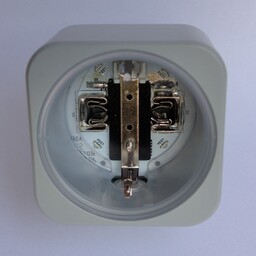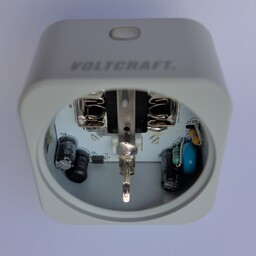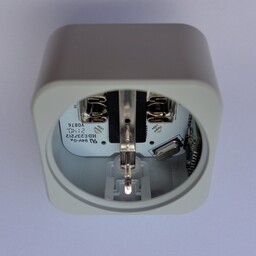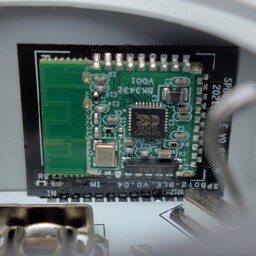spb012ble
The spb012ble, better known as Voltcraft SEM6000 SE, is a “smart
meter” plug with the following features:
- Remote control via Bluetooth and Android/iOS app
- Energy measurement with hourly (24), daily (30), monthly (12) statistics
plus current power, voltage, current and frequency.
- Scheduler with 12 slots
- Timer
- Random mode (anti-burglar)
It looks very similar to the revogi Smart Meter Plug EU and may be a
rebranded version.
This repository contains documentation on the hardware and firmware,
as well as software to control the “smart meter”.
Software
To install the software, clone this repository:
git clone https://codeberg.org/ldb/spb012ble.git
virtualenv -p python3 sandbox
source sandbox/bin/activate
pip install .
Controlling the device works like this:
spb012ble-monitor connect:A3:00:00:00:08:16 auth:0000 sync \
switch:on led:on measure
Hardware
The device is marked as model no. SEM 6000 40th, but sold as Voltcraft
SEM6000 SE. On the bottom in the hole for the type E plug a screw can
be removed. This allows removing the cover of the female socket on the
opposite side.
This reveals a transparent plastic ring, which is slightly glued. It
can be removed with a guitar pick or thin plastic piece.
On the bottom of the device there are a few capacitors and resistors,
as well as four RGB-LED’s for the light ring.
The top half only carries a crystal osciallator.
The microcontroller PCB (green), which is connected to a flexible
PCB (black), connects to the left side of the main PCB (white).
The microcontroller board is marked with BK3432 V001. The flexible PCB
has the marking SPB012-BLE V0.05 RW, 2021.08.31
The Bluetooth chip is marked as Beken BK3432 EU024JFE, an ARM968E
microcontroller with built-in Bluetooth 4.2 or 5.0
transceiver. The antenna is to the left.
The remaining housing seems to be glued together, which prevents further
non-destructive analysis. There must be a mechanical relais hidden
in the plug, responsible for the noticeable click when turning it on
or off. Also, according to the magazine c’t, it uses a RN8209D chip
for measurements.
Firmware
The meter’s firmware is updateable through the smartphone app. It is
fetched via the URL https://upgrade.revogi.com/?SN=<sn>, where sn
is a hex-encoded string that can be read from the GATT endpoint
0000fff1-0000-1000-8000-00805f9b34fb and contains an identifier,
as well as software and hardware revision. For hardware revision 3
devices are currently shipped with firmware version v1.16. That version
is not available for download, but v1.17 is part of the Android app as
bk3432_ble_app_app22.bin. v1.18 is available on the update servers,
but currently not advertised for updates yet.
The downloadable firmware image has a 16 byte header followed by the
interrupt vector.
typedef struct {
uint32_t crc32;
uint16_t version;
uint16_t length; /* Image length in 4 byte blocks */
uint32_t uid;
uint8_t unknown1, unknown2;
uint16_t unknown3;
} imageHeader_t;
It looks like it is mapped at address 0x0001b020. Most of the code
is run in ARM Thumb mode.
A high-level datasheet for the BK3432 as well as a (semi-public) SDK
are floating around the internet. According to that SDK the firmware
runs the proprietary RivieraWaves Bluetooth real-time operating
system (RTOS). Certain parts of this OS are not upgradeable over-the-air
(OTA), including the kernel and the Bluetooth stack itself. Thus the
OTA image above only contains the application-specific code of the
spb012ble.
The RN8209D is connected to the microcontroller through the UART2
interface at 9600 baud while UART1 at 115200 baud seems to be used
for debugging messages. Every 500 ms the firmware polls the following
registers in order:
- PowerPA (Active Power A).
The average power over some unknown period of time. It is updated
every 290 ms. Negative values are simply inverted. If the measured
value changes by less than 51 mW the old value is used. A value
less than 500 mW is turned into zero.
- URms (Voltage RMS).
- IARms (Current A RMS).
Similarly to the power measurements, changes less than 20 mA will
result in the old value being used. A value less than 20 mA is
reported as zero.
- UFreq (Voltage Frequency). Updated only every 640 ms.
Power, voltage and current can be calibrated via the command 240 while the
UFreq register value is scaled interally by the constant 0x6d3d3, as
described by the RN8209D datasheet on page 25.
\begin{equation*}
\begin{aligned}
P &= \left \lfloor \frac{\textrm{PowerPA} \cdot P_{calib}}{1000} \right \rfloor \\
U &= \left \lfloor \frac{\textrm{URms}}{U_{calib}} \right \rfloor \\
I &= \left \lfloor \frac{\textrm{IARms} \cdot I_{calib}}{1000} \right \rfloor \\
f &= \left \lfloor \frac{\left \lfloor \frac{3579545}{8} \right \rfloor}{\textrm{UFreq}} \right \rfloor
\end{aligned}
\end{equation*}
Bugs
- Accumulation accuracy
The current power readout is accumulated every five seconds,
which is rather slow for quickly-changing loads like PC power
supplies. This value is truncated to 1 W resolution for hourly
energy statistics without proper rounding and propagated from
there to daily and monthly statistics.
/* Runs every five seconds */
powerSum += power;
if (minute == 59 && second == 55) {
energy += powerSum / (SECONDS_PER_HOUR / FIVE_SECONDS) / 1000;
update_energy_history_24h();
powerSum = 0;
This can result in significant under-reporting of energy use for
devices with low power draw of a few watts.
- Input checks
Inputs checks in the firmware are basically nonexistent. For
instance the Android app allows setting power limits from 1000 W
to 4000 W, while the firmware happily accepts any value from
0 W to 65535 W.
globalPowerLimit = (packet[4] << 8) | packet[5];
status_reply(5, 0);
flash_settings();
The same applies to the device name, which overwrites arbitrary memory if too long:
memset(globalDeviceNameA, 20);
memcpy(globalDeviceNameA, &packet[4], packet[1]-3);
memset(globalDeviceNameB, 20);
memcpy(globalDeviceNameB, &packet[4], packet[1]-3);
globalDeviceNameBLen = 20;
status_reply(2, 0);
flash_settings();
- Scheduler rules soft-brick
- Under unknown circumstances the firmware crashes when adding or
removing scheduler rules. The device will enter a soft-bricked
state and not advertise any GATT services via BLE, making it
impossible to control it remotely. Power-cycling only temporarily
fixes the issue. Thus a full device reset is required to restore
normal operation.
- Authentication
The client unlocks the meter using a four-digit PIN code. If that
client – for whatever reason – disconnects the meter will
advertise itself again over BLE and any other client can access
the device without providing the PIN code, since it is already
unlocked.
Brute-forcing four digits takes about 30 minutes worst-case at
a measured average rate of 5.7 tries per second.
But even worse: The PIN can be reset to the default without
prior authentication due to how commands are dispatched:
bool checksum_correct = verify_checksum(packet);
if (checksum_correct == false) {
return 0;
}
uint8_t action = packet[2];
if (action == 23) {
handle_authentication(&packet[4]);
} else if (action == 240) {
handle_calibration(&packet[4]);
} else if (action == 48) {
handle_set_mac(&packet[4]);
}
if (is_authenticated != true) {
return 0;
}
if (action == 12) {
- Switch behavior
- The physical switch on the top of the device is not debounced
properly through hard- or software. Pressing it often results
in the device switching off and on again or vice versa.
- Default device name
- While purely cosmetic, the default device name is “Volcraft”,
lacking a t.





